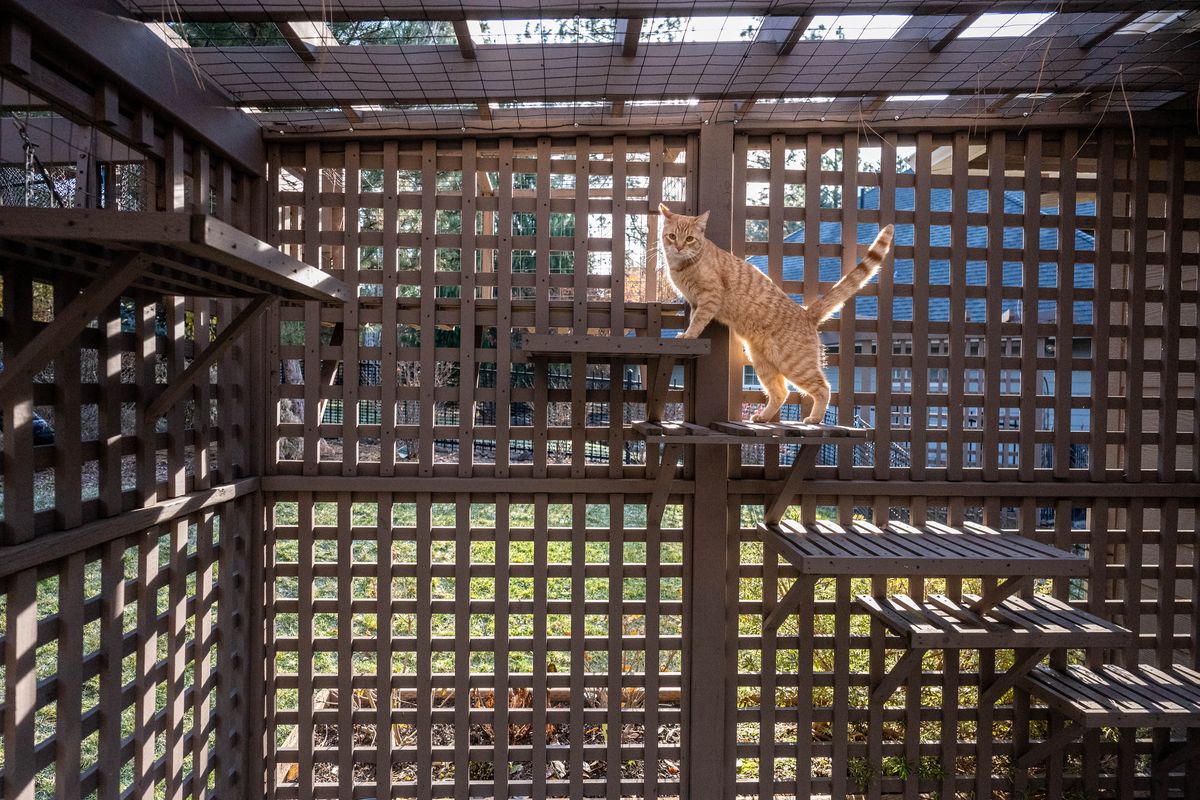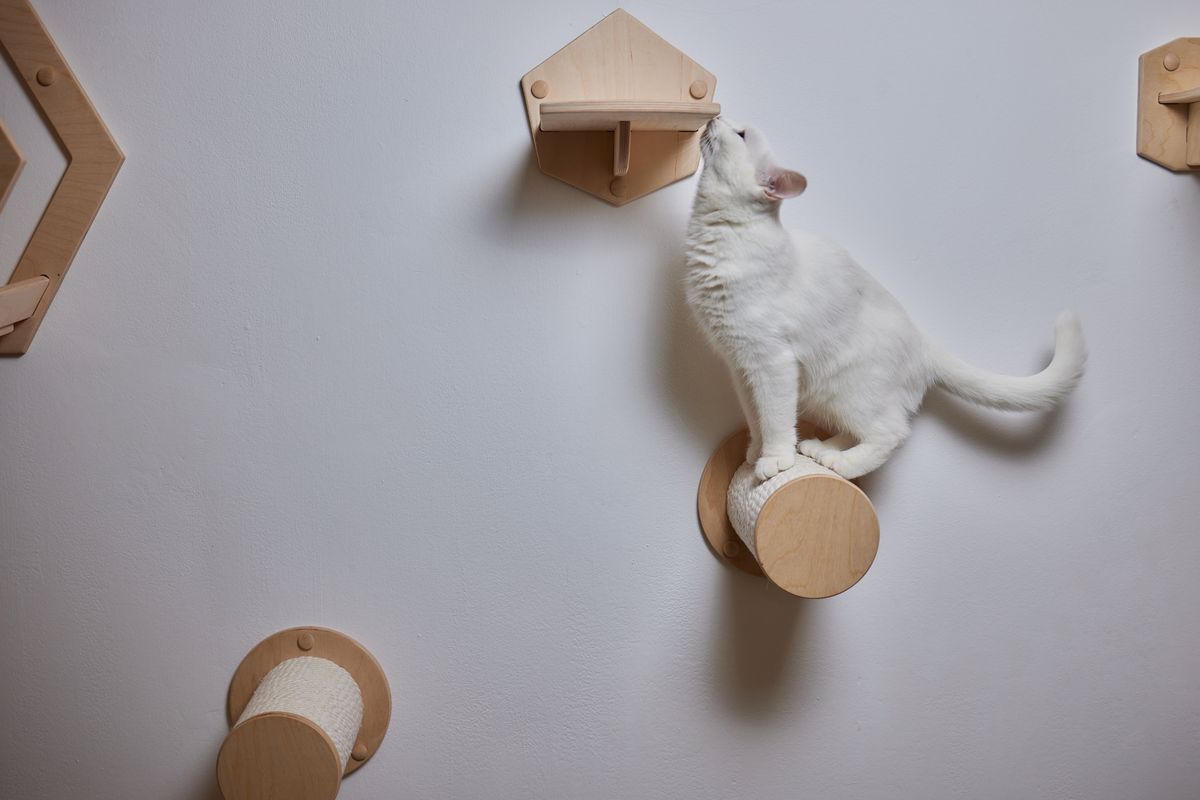Why cats love to be up high — and how to DIY a lofty spot for yours
Retired musicians Cathy Cole and Kadie Nichols built a house off Rockwood Boulevard that was designed with their cats in mind. Make your own DIY cat loft with a few simple steps. (COLIN MULVANY/THE SPOKESMAN-REVIEW)
It’s a scene familiar to most cat owners: Your fluffy friend is curled up on top of a kitchen cabinet, purring like a radiator, or sprawled on your dresser amid a sea of knickknacks they knocked over during their biiiiiig stretch.
Many domesticated cats gravitate toward high-up hangout spots, reigning above our (their?) living rooms, bedrooms and kitchens. But what’s so attractive about lounging at such altitudes? Is it a show of dominance over the home – an affirmation of the commonly held human belief that cats think they’re superior?
According to cat behavior experts, not really.
“They are better than us, but that’s not why they go up high,” jokes Rita Reimers, a cat behaviorist and co-founder of the Cat Behavior Alliance.
Nearly all domesticated cat behavior can be explained by survival instinct, including their propensity to situate themselves in lofted areas. As both predator and prey, resting at a high vantage point allows cats to eye their potential dinner while avoiding becoming someone else’s (yes, this intuition persists even for house cats whose meals get delivered in a dish). “Everything a cat does is for the survival of themselves and their species,” Reimers said. It’s less about showing superiority over the home and more a way to gain the most advantageous view of their resources and environment.
While we humans tend to think of our living spaces two-dimensionally, mapping out floor plans and furniture arrangements according to square footage, cats view their world in three dimensions. As natural climbers, they’re always looking for ways to get in the air. “They evolved in areas where they took advantage of trees and rocks and being up high so that they could feel safe and also see where their prey were,” said Marci Koski, a wildlife biologist and certified feline behavior specialist.
So without spending hundreds of dollars on a gaudy cat tower, how can you construct comfortable vertical spaces for your four-legged roommate(s) that will keep the whole household happy? We’ve got you covered.
First, observe where your cat likes to hang out
It’s no use constructing an elaborate perch or shelving system in a room your cat doesn’t naturally frequent. “I go into homes where people have these really great wall setups with all these wall shelves, and it’s like the perfect jungle gym for their cats. And they go, ‘Well, my cat never uses it.’ I look at what’s there, and it’s set up in the basement where there’s no window to look out of, or people don’t hang out in the basement very much,” Koski said.
Get to know where your cat prefers to spend most of their time – chances are this will also be a space where you spend a lot of your time or a room in your home that has a window with an entertaining view. Despite their self-sufficiency, aloof stares as we coo about how much we love them and general can’t-be-bothered demeanor, your cats do like to be around you, Koski said.
Identify your cat’s favorite outlook and add a low-effort hammock with suction cups. If you really want your cat to see a show, install a bird feeder outside the window. Take note of which spots in each room they gravitate to; there may be something particularly attractive about the surface of a piece of furniture or the smell of an object that you can replicate elsewhere.
It’s also helpful to clock where your cat seeks comfort when they’re feeling unsafe or scared, and what spaces they tend to avoid. If they usually visit a certain room or corner when guests come over or children abound, adding vertical hangouts to those areas can put them even more at ease during stressful situations. On the flip side, if they run for the hills at the sound of a front door opening, putting a perch in a place with heavy foot traffic will be a waste of your time.
Use what you already have
There’s no shortage of DIY cat tower and shelf tutorials online. Linda Hall, co-founder of the Cat Behavior Alliance with Reimers, recommends using materials or supplies that may already be in your home – plywood, old shelving units, or old blankets and fabric. Her cats were lounging around on an unwanted $25 plastic shelving unit from Walmart that she was planning to put on the curb anyway, so she refurbished it by painting it teal and wrapping the poles in sisal rope, a material that cats naturally love to scratch. “They think it’s the greatest cat tree ever!” she said.
If you don’t have a pre-existing shelf to repurpose for your feline cohabitants, most hardware stores carry budget-friendly mounting or floating shelves (you can even use a piece of plywood) that can be easily affixed to a wall of your and your cat’s choosing. Just be sure to pick up some sturdy wall mounts to avoid any major issues, and add a few wooden planks for stairs if there isn’t already a natural path of ascension.
Spruce up the space
If you’re making a new hangout to redirect your cat’s attention from a more problematic area – say, the dining room table – you’ll need to dress it to their liking. (The saying that dogs have owners and cats have staff is sounding increasingly true as this guide continues.)
Think about the materials and fabrics your cat enjoys. Even just cutting off a square of a blanket, laying down an old sweater, or taping down some nonslip drawer lining on a raised platform or shelf can do the trick. If your lofted space is in a cooler or shaded part of the home, the cozier the material the better, according to Koski. Cats have a high thermal neutral zone – the temperature at which the body doesn’t need to spend energy to heat up or cool down. Their bodies are happiest between 83 and 100 degrees, yet we usually keep our homes somewhere in the high 60s to low 70s; this explains their penchant for sunny patches. Once you’ve made the spot warm and toasty, you can sprinkle catnip or silvervine (a catnip alternative), on the fabric to make it even more attractive. As they explore their new space, reward them with treats and playtime.
Don’t create dead ends
Make sure your cat has more than one way of getting up to and down from their mounted perch. Not only does this avoid traffic jams in multi-cat households (should another four-legged housemate attempt to climb up for a turf war), having an escape route will prevent panic should something spook your cat. This could mean adding a piece of furniture where they can plunk down on their way to the floor or installing a few extra steps around the shelf or perch.
For multi-cat households, avoid conflict
While cats tend to buck human understanding of hierarchical social structures, cohabitating indoor felines do have loose structures of dominance and submission that you should take into consideration.
To avoid any catfights (sorry), try to offer multiple vertical options throughout the home, so one cat is not intruding on another’s established territory. You can also create a shelf for each cat on the same wall or in the same room, so dominant and submissive personalities have a safe place to themselves.
As Reimer said, typically the higher the cat hangs out, the higher it sits in the social group.
It’s about compromise
Having a cat is a daily exercise in negotiation, an often ridiculous version of “Let’s Make A Deal” that we humans rarely win.
Sometimes, even after you’ve created what amounts to a cat paradise in front of a bright, south-facing window, your feline friend will simply decide they still prefer your trinket-clad dresser. As Hall said, “You can’t convince a cat anything they do is wrong.”
You may have to suck it up and rearrange your objects to make space for your cat on your furniture, or use a sticky, tack-like glue (see: earthquake putty) to avoid any knickknack … cat-astrophes
.

